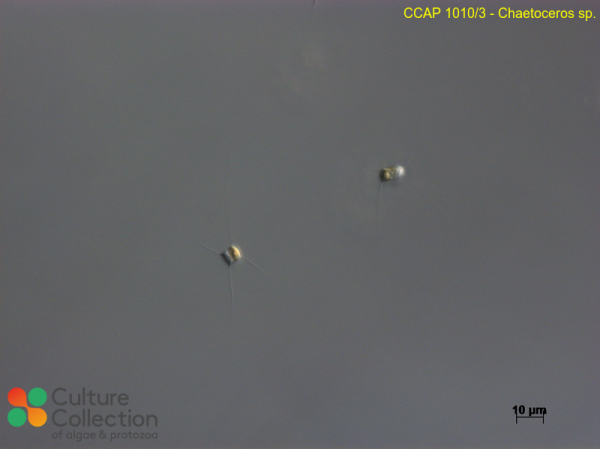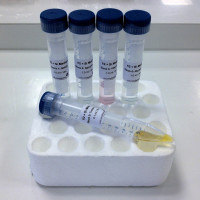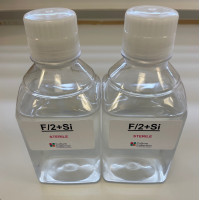References [ 43 ]
Leonardos N & Geider RJ (2004) Effects of nitrate:phosphate supply ratio and irradiance on the C:N:P stoichiometry of Chaetoceros muelleri. European Journal of Phycology 39: 173-180.
Moniz MBJ & Kaczmarska I (2010) Barcoding of diatoms: Nuclear encoded ITS revisited. Protist 161: 7-34.
Christophersen G, Torkildsen L & van der Meeren T (2006) Effect of increased water recirculation rate on algal supply and post-larval performance of scallop (Pecten maximus) reared in a partial open and continuous feeding system. Aquacultural Engineering 35: 271-282.
Suggett DJ, Moore CM, Hickman AE & Geider RJ (2009) Interpretation of fast repetition rate (FRR) fluorescence: Signatures of phytoplankton community structure versus physiological state. Marine Ecology - Progress Series 376: 1-19.
Sandaa R-A, Brunvold L, Magnesen T & Bergh Ø (2008) Monitoring the opportunistic bacteria Pseudoalteromonas sp. LT-13 in a great scallop, Pecten maximus hatchery. Aquaculture 276: 14-21.
Natrah FMI, Kenmegne MM, Wiyoto W, Sorgeloos P, Bossier P & Defoirdt T (2011) Effects of micro-algae commonly used in aquaculture on acyl-homoserine lactone quorum sensing. Aquaculture 317: 53-57.
Magnesen T & Jacobsen A (2012) Effect of water recirculation on seawater quality and production of scallop (Pecten maximus) larvae. Aquacultural Engineering 47: 1-6.
Lelong AA, Haberkorn H, Le Goïc N, Hégaret H & Soudant P (2011) A new insight into allelopathic effects of Alexandrium minutum on photosynthesis and respiration of the diatom Chaetoceros neogracile revealed by photosynthetic-performance analysis and flow cytometry. Microbiology of Aquatic Systems 62: 919-930.
Azua I, Unanue M, Ayo B, Artolozaga I & Iriberri J (2007) Influence of age of aggregates and prokaryotic abundance on glucose and leucine uptake by heterotrophic marine prokaryotes. International Microbiology 10: 13-18.
Azua I, Unanue M, Ayo B, Artolozaga I, Arrieta JM & Iriberri J (2003) Influence of organic matter quality in the cleavage of polymers by marine bacterial communities. Journal of Plankton Research 25: 1451-1460.
Suggett DJ, MacIntyre HL & Geider RJ (2004) Evaluation of biophysical and optical determinations of light absorption by photosystem II in phytoplankton Limnology and Oceanography: Methods 2: 316-332.
DOI: none
Suggett DJ, Oxborough K, Baker NR, MacIntyre HL, Kana TM & Geider RJ (2003) Fast repetition rate and pulse amplitude modulation chlorophyll a fluorescence measurements for assessment of photosynthetic electron transport in marine phytoplankton European Journal of Phycology 38: 371-384.
Volkman JK, Jeffrey SW, Nichols PD, Rogers GI & Garland CD (1989) Fatty acid and lipid composition of 10 species of microalgae used in mariculture Journal of Experimental Marine Biology and Ecology 128: 219-240.
DOI: none
Leonardos N & Lucas IAN (2000) The use of larval fatty acids as an index of growth in Mytilus edulis L. larvae. Aquaculture 184: 155-166.
DOI: none
Leonardos N & Lucas IAN (2000) The nutritional value of algae grown under different culture conditions for Mytilus edulis L. larvae. Aquaculture 182: 301-315.
DOI: none
Cripps G, Lindeque P & Flynn KJ (2014) Have we been underestimating the effects of ocean acidification in zooplankton? Global Change Biology 20: 3377-3385.
McLellan MR (1989) Cryopreservation of diatoms. Diatom Research 4: 301-318.
Shen C & Hopkinson BM (2015) Size scaling of extracellular carbonic anhydrase activity in centric marine diatoms. Journal of Phycology 51: 255-263.
Slocombe SP, Zhang QY, Ross M, Anderson A, Thomas NJ, Lapresa A, Rad Menéndez C, Campbell CN, Black KD, Stanley MS & Day JG (2015) Unlocking nature's treasure-chest: Screening for oleaginous algae. Scientific Reports 5: 09844.
Hønsvall BK, Altin D & Robertson LJ (2016) Continuous harvesting of microalgae by new microfluidic technology for particle separation. Bioresource Technology 200: 360-365.
Cripps G, Lindeque P & Flynn K (2014) Parental exposure to elevated pCO2 influences the reproductive success of copepods. Journal of Plankton Research 36: 1165-1174.
Cripps G, Flynn KJ & Lindeque PK (2016) Ocean acidifcation affects the phyto-zooplankton trophic transfer efficiency. PLoS ONE 11(4): e0151739.
Bailey A, Thor P, Browman HI, Fields DM, Runge J, Vermont A, Bjelland R, Thompson C, Shema S, Durif CMF & Hop H (2017) Early life stages of the Arctic copepod Calanus glacialis are unnaffected by increased seawater pCO2. ICES Journal of Marine Science 74: 996-1004.
Long M, Paul-Pont I, Hégaret H, Moriceau B, Lambert C, Huvet A & Soudant P (2017) Interactions between polystyrene microplastics and marine phytoplankton lead to species-specific hetero-aggregation. Environmental Pollution 228: 454-463.
Bailey A, De Wit P, Thor P, Browman HI, Bjelland R, Shema S, Fields DM, Runge JA, Thompson C & Top H (2017) Regulation of gene expression is associated with tolerance of the Arctic copepod Calanus glacialis to CO2-acidified sea water Ecology and Evolution 7: 7145-7160.
Pousse E, Flye-Sainte-Marie J, Alunno-Bruscia M, Hégaret H & Jean F (2018) Sources of paralytic shellfish toxin accumulation variability in the Pacific oyster Crassostrea gigas Toxicon 144: 14-22.
Delisle L, Petton B, Burguin JF, Morga B, Corporeau C & Pernet F (2018) Temperature modulate disease susceptibility of the Pacific oyster Crassostrea gigas and virulence of the Ostreid herpesvirus type 1 Fish & Shellfish Immunology 80: 71-79.
Long M, Tallec K, Soudant P, Lambert C, Le Grand F, Sarthou G, Jolley D & Hégaret H (2018) A rapid quantitative fluorescence-based bioassay to study allelochemical interactions from Alexandrium minutum Environmental Pollution -: -.
de Lorgeril J et al. (2018) Immune-suppression by OsHV-1 viral infection causes fatal bacteraemia in Pacific oysters Nature Communications 9: 4215.
Fuhrmann M, Richard G, Quéré C, Petton B & Pernet F (2019) Low pH reduced survival of the oyster Crassostrea gigas exposed to the Ostreid herpesvirus 1 by altering the metabolic response of the host Aquaculture 503: 167-174.
Castrec J, Hégaret H, Alunno-Bruscia M, Picard M, Soudant P, Petton B, Boulais M, Suquet M, Quéau I, Ratiskol D, Foulon V, Le Goic N & Fabioux C (2019) The dinoflagellate Alexandrium minutum affects development of the oyster Crassostrea gigas, through parental or direct exposure Environmental Pollution 246: 827-836.
Pousse E et al. (2019) Modelling paralytic shellfish toxins (PST) accumulation in Crassostrea gigas by using Dynamic Energy Budgets (DEB) Journal of Sea Research 143: 152-164.
Long M, Tallec K, Soudant P, Le Grand F, Donval A, Lambert C, Sarthou G, Jolley DF & Hégaret H (2018) Allelochemicals from Alexandrium minutum induce rapid inhibition of metabolism and modify the membranes from Chaetoceros muelleri Algal Research 35: 508-518.
Seoane M, González-Fernández C, Soudant P, Huvet A, Esperanza M, Cid A & Paul-Pont I (2019) Polystyrene microbeads modulate the energy metabolism of the marine diatom Chaetoceros neogracile Environmental Pollution 251: 363-371.
González-Fernández C, Toullec J, Lambert C, Le Goic N, Seoane M, Moriceau B, Huvet A, Berchel M, Vincent D, Courcot L, Soudant P & Paul-Pont I (2019) Do transparent exopolymeric particles (TEP) affect the toxicity of nanoplastics on Chaetoceros neogracile? Environmental Pollution 250: 873-882.
Long M, Holland A, Planquette H, González Santana D, Whitby H, Soudant P, Sarthou G, Hégaret H & Jolley DF (2019) Effects of copper on the dinoflagellate Alexandrium minutum and its allelochemical potency Aquatic Toxicology 210: 251-261.
Diéguez AL, Balboa S, Magnesen T, Jacobsen A, Lema A & Romalde JL (2019) Comparative study of the culturable microbiota present in two different rearing systems, flow‐through system (FTS) and recirculation system (RAS), in a great scallop hatchery Aquaculture Research 51: 542-556.
Pernet F, Lugué K & Petton B (2021) Competition for food reduces disease susceptibility in a marine invertebrate Ecosphere 12(4): e03435.
Remize M, Planchon F, Loh AN, Le Grand F, Mathieu-Resuge M, Bideau A, Corvaisier R, Volety A & Soudant P (2021) Fatty acid isotopic fractionation in the diatom Chaetoceros muelleri Algal Research 54: 102164.
Loor A, Bossier P, Wang D, De Bels L, Van den Broeck W, Nevejan N & Declercq A (2023) Effect of continuous dietary administration of the Saccharomyces cerevisiae yeast, Δmnn9, on Pacific oyster ((Crassostrea gigas) juveniles: Immunological and histopathological findings after Vibrio coralliilyticus challenge Aquaculture 574: 739644.
Roux P, García-Corona JL, Ragueneau S, Schapira M, Siano R, Pernet F, Queau I, Malestroit P, Tallec K & Fleury E (2024) Ecophysiological response of the cupped oyster Crassostrea gigas exposed to the green dinoflagellate Lepidodinium chlorophorum Aquaculture 584: 740644.
Gaillard S, Small HJ, Ayache N, Tanniou S, Hess P, Réveillon D, Harris CM, Harris TM, Scott GP, MacIntyre A & Reece KS (2024) Investigating the role of allelochemicals in the interaction between Alexandrium monilatum and other phytoplankton species Harmful Algae 139: 102706.
Petrucciani A, Maso S & Norici A (2024) Ecophysiological behaviour of different diatoms in response to copepod signals Phycologia 63(1): -.




